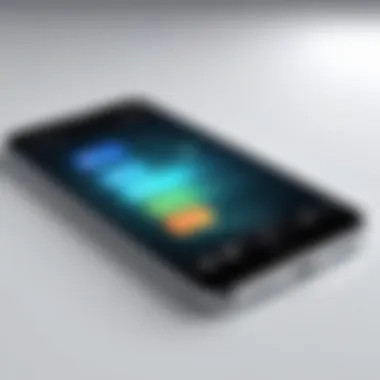Understanding Mobile Push Notifications: A Comprehensive Guide


Intro
Mobile push notifications are an integral part of modern app communication. They serve as a direct link between applications and users. By sending timely information, these notifications can enhance user engagement significantly. Understanding their mechanisms and implications is essential for any developer or marketer aiming to optimize their mobile strategy.
Push notifications deliver messages to users’ devices, prompting them to open an app or take action. They can inform users about new features, reminders for important tasks, or updates on ongoing activities. Nevertheless, successful implementation of push notifications involves more than simply sending messages.
Significance of Mobile Push Notifications
Push notifications hold substantial value in today's digital landscape. Research shows that well-implemented notifications can boost user retention rates and increase interaction with the app. Effective messaging captures users' interest, driving them back to the app. Therefore, optimizing the notifications sent can contribute significantly to the overall success of a mobile application.
Mechanisms Behind Push Notifications
Push notifications utilize various protocols and technologies to deliver messages. These primarily include the Apple Push Notification service for iOS and Firebase Cloud Messaging for Android. Furthermore, developers must ensure their applications are capable of handling notifications gracefully.
"Effective push notifications not only reach users but also resonate with their needs and preferences."
Challenges Faced
However, there are challenges associated with mobile push notifications. Overuse can lead to notification fatigue, causing users to disengage. Additionally, privacy concerns are paramount, as users become more cautious about their data. Marketers and developers must navigate these challenges carefully to maximize the advantages while minimizing potential drawbacks.
In the sections that follow, this article will delve deeper into the technology behind mobile push notifications, best practices for effective messaging, and ethical considerations regarding user privacy. By examining these aspects in detail, we aim to provide a comprehensive understanding of mobile push notifications.
Through this exploration, both developers and marketers will gain valuable insights that can help them leverage push notifications effectively.
Prolusion to Mobile Push Notifications
Mobile push notifications serve as a bridge between applications and their users. Understanding their functionality is crucial for professionals in IT and marketing. When effectively utilized, these notifications engage users and enhance retention rates. They can drive important actions, prompt responses, and facilitate deeper interaction with applications. The increasing prevalence of mobile devices in daily life makes mastering this tool even more essential.
Defining Mobile Push Notifications
Mobile push notifications are messages sent from applications to users' mobile devices. They appear on the home screen or notification area, alerting users to new content or updates from an app. These notifications can include textual content, images, and even action buttons. The beauty of push notifications lies in their ability to reach users instantly, even when the app is not actively in use. **This direct communication line fosters user engagement **
Push notifications can be categorized into two main types: transactional and promotional. Transactional notifications deliver essential information, like booking confirmations or order updates. On the other hand, promotional notifications aim to stimulate user activity within an app, such as alerts about sales or new features. Notably, the success of push notifications hinges on their relevance and timing. Poorly timed or irrelevant messages can frustrate users, leading to unsubscriptions.
Historical Context and Evolution
The history of mobile push notifications tracks the evolution of mobile technology and user engagement strategies. Initially, push notifications emerged with the introduction of Apple's iOS in 2009 through the Apple Push Notification service (APNs). This allowed developers to send alerts and updates directly to users' devices. Soon after, Google's Firebase Cloud Messaging (FCM) became a significant player, providing an extensive framework for managing notifications across different platforms.
As mobile applications became more prevalent, so did the strategies for utilizing notifications. Early implementations focused solely on promotional content. However, as the demands of users evolved, so did the approach. Today, businesses recognize the value of personalization and segmentation. This ensures that notifications resonate with specific user segments.
Over the years, advancements in technology have shaped the sophistication of push notifications. Integration with data analytics allows businesses to fine-tune their strategies based on user behavior and preferences. This evolution highlights the dynamic nature of mobile push notifications and their critical role in modern digital communication.
The Technology Behind Push Notifications
Understanding the technology driving mobile push notifications is crucial for anyone interested in maximizing their effectiveness. As organizations seek to enhance user engagement and retention, a solid grasp of the infrastructure and protocols involved becomes increasingly important. This section will cover an overview of notification systems, delve into the roles of mobile operating systems, and explore the specific protocols and standards shaping the landscape of push notifications.
Overview of Notification Systems
Notification systems act as the backbone for delivering messages to a user’s device, regardless of whether they are in the app, using another app, or have locked their screens. These systems work by leveraging a cloud infrastructure to send information through specific channels. The efficiency of these systems is paramount for user experience. They enable real-time updates and alerts, keeping users informed without requiring constant manual checking.
The effectiveness of these systems lies in their ability to reach users precisely when needed. Features such as scheduling and triggering notifications based on user behavior or preferences are crucial. Thus, understanding the internal workings of these systems allows developers and marketers to optimize notifications for maximum impact.
The Role of Mobile Operating Systems
Mobile operating systems, specifically iOS and Android, play a significant role in how notifications are managed and displayed. Each of these systems possesses unique features that directly impact user experience.
- iOS: It integrates a user-friendly interface with APNs (Apple Push Notification service) that efficiently handles notifications while prioritizing user privacy. iOS provides detailed control over notification settings, allowing users to tailor what they receive and how they are notified.
- Android: Uses Firebase Cloud Messaging (FCM) to deliver notifications seamlessly across apps and devices. Android’s flexibility allows for extensive customization, making it possible to engage users through varied approaches fitting different applications.


The interplay between OS capabilities and notification systems ultimately determines how effectively messages reach their audiences. This architectural collaboration is indispensable in enhancing user satisfaction and retaining engagement.
Protocols and Standards in Use
Mobile push notifications rely on a series of protocols and standards that are fundamental to their delivery mechanisms. Three primary protocols are instrumental in this process: APNs, FCM, and WNS.
APNs
The Apple Push Notification service (APNs) is a cornerstone for developers aiming to send notifications on iOS devices. One significant aspect of APNs is its ability to manage large volumes of notifications efficiently. Key characteristics include:
- Reliability: APNs is designed to deliver notifications even when the app is not running, ensuring messages reach users promptly.
- Security: It employs advanced encryption, securing the data transmitted, thus fostering user trust. This is essential for applications requiring sensitive information handling.
However, a unique feature of APNs is its reliance on device tokens for identifying user devices. This can sometimes lead to complications in notification delivery if tokens become obsolete.
FCM
Firebase Cloud Messaging (FCM) serves a similar purpose to APNs but for Android devices. A standout aspect of FCM is its integration with Firebase services, allowing for a more holistic approach to app development. The key characteristic includes:
- Cross-Platform Functionality: FCM supports messaging across Android, iOS, and web applications, making it versatile for developers working in multi-platform environments.
- Analytics Integration: FCM's ability to pair with Firebase analytics provides insights into user engagement, helping refine notification strategies.
Its unique feature lies in grouping notifications, allowing developers to aggregate multiple alerts into a single notification stream. This can reduce clutter and improve user experience but may sometimes lead to missed individual messages.
WNS
Windows Notification Service (WNS) is vital for developers creating applications on Windows platforms. The specific aspect of WNS is its focus on desktop and Windows-based applications. Key highlights include:
- Real-Time Notifications: WNS allows for instant delivery of notifications to Windows devices, ensuring timely communication with users.
- Customization Options: Developers can craft tailored notifications that cater to specific user preferences and application contexts.
A unique feature of WNS is its ability to support toast notifications and tile updates, enhancing user engagement through visible real-time interactions. However, there may be limitations in user control, which could affect user satisfaction.
In summary, the technology behind mobile push notifications combines various systems, protocols, and characteristics, each contributing to effective communication with users. A deep understanding of these elements is essential for maximizing the benefits of mobile push notifications.
Benefits of Mobile Push Notifications
Mobile push notifications offer significant advantages for developers and marketers alike. They represent a direct line of communication with users, allowing for immediate engagement. The importance of understanding these benefits cannot be overstated; it enhances user interactions and elevates overall app performance. This section will delve into three key benefits: enhancing user engagement, increasing retention rates, and generating revenue.
Enhancing User Engagement
Mobile push notifications can substantially improve user engagement. When used effectively, notifications serve as a reminder for users to revisit an application. They can inform users of new content, special offers, or event updates tailored to their preferences.
- Personalized Messages: Customization is crucial. By analyzing user behavior and preferences, developers can send targeted notifications. For instance, a user who frequently engages with sports content can receive alerts about their favorite teams or events.
- Real-Time Updates: Notifications enable real-time communication. This immediacy cultivates a sense of urgency, prompting users to act. For example, breaking news alerts or flash sales compel users to check back often.
Effective push notifications can lead to higher interaction rates and better user experience. According to research, personalized notifications can boost open rates significantly. By providing relevant information, apps can strengthen user loyalty.
Increasing Retention Rates
Retaining users is a critical challenge for many applications. Push notifications play a vital role in keeping users engaged and revisiting the app regularly. Engaged users are less likely to abandon the app.
- Onboarding Reminders: For new users, sending reminders during onboarding can help guide them through app features. This encourages exploration and reduces the likelihood of uninstallation.
- Win-Back Strategies: For users who have become inactive, tailored notifications can encourage them to return. For instance, offering a personalized offer can reignite interest and increase the chances of re-engagement.
A well-timed push notification can create a connection with the user, showing them that the app adds value to their lives. Research indicates that retention rates improve significantly with the strategic use of push notifications.
Generating Revenue
Finally, mobile push notifications can directly impact revenue generation. They provide a channel for promoting products and services effectively.
- Targeted Promotions: Notifications can highlight new products or sales specifically to users who have shown interest. This method increases the likelihood of conversion.
- Abandoned Cart Reminders: For e-commerce apps, reminders sent to users who left items in their cart can recover potentially lost sales. A gentle nudge can be enough to convince users to complete their purchase.


Successful revenue generation often hinges on the quality and relevance of push notifications. Developers must present offers that resonate with the users. Integrating data analytics helps in optimizing notification strategies.
"Push notifications can be the difference between a thriving app and a forgotten one."
In summary, the benefits of mobile push notifications are multi-faceted and crucial for enhancing user engagement, increasing retention rates, and generating revenue. With careful implementation and consideration of user preferences, these notifications can serve as a powerful tool in any mobile marketing strategy.
Challenges with Push Notifications
Mobile push notifications serve as a double-edged sword for businesses aiming to connect with users. While they offer a compelling avenue for user engagement, they also present significant challenges. Understanding these challenges is crucial for developers and marketers alike. When not handled effectively, push notifications can lead to user frustration, over-saturation, and technical issues. Each of these elements must be navigated thoughtfully to optimize the effectiveness of push notification strategies.
User Frustration and Unsubscription
One of the most immediate challenges faced by businesses using mobile push notifications is user frustration. Excessive or irrelevant notifications can lead to annoyance and ultimately drive users to unsubscribe from future messages. Individuals may find push notifications intrusive, especially if they disrupt their daily activities. According to recent studies, a significant percentage of users have disabled notifications from apps they find bothersome, with some even choosing to uninstall applications altogether.
To prevent frustration, it is vital to strike a suitable balance between frequency and relevance. Businesses should employ strategies such as segmentation to send targeted messages based on user preferences and behavior. Delivering information that resonates with the audience can help maintain engagement while minimizing negative perceptions.
Over-Saturation and Message Fatigue
Over-saturation is another profound issue in mobile push notifications. As users receive an increasing number of notifications daily, they may experience message fatigue. This phenomenon refers to the diminishing impact notifications have on user behavior due to their sheer volume. Users start ignoring notifications or may even enable “Do Not Disturb” modes to escape the deluge of alerts.
To combat over-saturation, it is essential for brands to consider the timing and context of their notifications. Businesses should limit the number of notifications sent and ensure that each message provides valuable information. A well-thought-out messaging strategy that prioritizes quality over quantity can significantly improve user interactions.
Technical Issues and Performance
Technical issues also pose a challenge to the effectiveness of mobile push notifications. Problems can arise in various aspects, including delivery failures or slow loading times for content linked within the notifications. When messages do not reach users as intended, or if the associated content is unresponsive, frustration can escalate. This can erode trust and credibility in the brand offering those notifications.
To mitigate technical challenges, companies must invest in robust delivery systems and infrastructure. Testing notification delivery under various conditions is essential to ensure consistent performance. Moreover, employing real-time analytics can help monitor the status of notifications, allowing for quick troubleshooting and adaptations based on user feedback.
In summary, addressing the challenges associated with mobile push notifications is imperative. Understanding user frustration, over-saturation, and technical performance can guide businesses in their approach, ensuring that push notifications remain a valuable tool in their strategy.
Crafting Effective Push Notifications
Crafting effective push notifications is vital for businesses and organizations looking to maximize user engagement. A carefully designed notification not only captures the user’s attention but also encourages interaction, driving specific outcomes. Given the vast amount of information users receive daily, standing out is crucial. Factors such as the audience, personalization, and design play critical roles in ensuring that messages resonate with recipients.
Understanding Your Audience
Understanding your audience is foundational in crafting relevant push notifications. The process starts with gathering data about user preferences, behavior, and demographics. By identifying what interests your audience, you can tailor notifications to address their specific needs. Audience segmentation helps in categorizing users based on their interaction history or preferences. This tailored approach ensures that messages are relevant, increasing the likelihood of user engagement. The more you understand your audience, the more effective your notifications will be.
Personalization and Targeting
Personalization is essential for modern mobile push notifications. Users are more likely to engage with messages that feel personal. Incorporating user names or referencing past interactions can create a more intimate connection. Effective targeting goes hand-in-hand with personalization. By using segmentation, messages can be directed to specific groups of users. For example, you might notify frequent buyers about a new product while sending special deals to those who have not engaged recently. This level of specificity ensures messages are meaningful, which can boost click-through rates.
Best Practices for Message Design
Timing
Timing in push notifications significantly impacts their effectiveness. The right timing can enhance the visibility of the message and increase interaction rates. For instance, sending notifications during peak usage hours when users are most active can garner more attention. Conversely, sending messages at odd hours can lead to frustration and increased unsubscriptions.
The key characteristic of timing is relevance to the user’s routine; therefore, analyzing user behavior can help identify optimal windows for engagement. However, it requires careful monitoring to find the sweet spot for each demographic.
Content
Content quality is another critical aspect of push notifications. The content should be concise yet informative. Users appreciate clarity and value. Highlighting the benefits or key information succinctly can lead to higher engagement levels. A good practice is to pose a question or create urgency in the message.
Unique to content is its adaptability; it can vary from promotional offers to informative updates, depending on the audience's needs. Nevertheless, if the content does not resonate or provides no value, users may quickly dismiss the notification.
Call to Action


A compelling call to action (CTA) is a crucial element of an effective push notification. It directs users on what to do next, whether it’s visiting a website, downloading an app, or making a purchase. An effective CTA is clear and persuasive. For example, phrases like "Shop Now" or "Learn More" guide users effectively.
The unique feature of a CTA is its ability to create a sense of urgency or exclusivity. Making users feel they might miss out if they don’t act immediately can drive engagement. However, if the CTA is too aggressive or unclear, it may deter users rather than encourage them.
Ethical Considerations and Privacy Issues
In the realm of mobile push notifications, ethical considerations and privacy issues are paramount. As this technology continues to evolve, the balance between effective communication and user respect has become more crucial. Companies must navigate these waters carefully, as failing to prioritize ethics can lead to user distrust and disengagement. This section examines the implications of ethical practices in push notifications, highlighting key elements like user consent, data security, and overall user privacy.
User Consent and Opt-In Processes
User consent is the cornerstone of ethical push notification strategies. It is essential that users have a clear understanding of what they are subscribing to. This includes being informed about the nature of the notifications they will receive and the frequency of these alerts. In many jurisdictions, regulations mandate that consent must be obtained explicitly, leading to the development of opt-in processes that prioritize transparency.
An effective opt-in process might include the following:
- Clear Language: Avoid technical jargon. Use simple terms to explain what users are consenting to.
- Direct Options: Allow users to choose specific types of notifications. For example, they might want updates on sales but not on new product launches.
- Easy Access: Make the opt-in process straightforward, ideally during the app installation or the first use.
Not only does this enhance user trust, but it also ensures compliance with laws like the General Data Protection Regulation (GDPR) in Europe, which emphasizes individual control over personal data.
Data Security and User Privacy
Data security is another critical aspect of ethical push notifications. As organizations collect data to personalize notifications, they must implement robust security measures to protect this information from unauthorized access and breaches. Users need to feel that their data is safe.
To address data security concerns, companies should consider the following protocols:
- Encryption: Encrypting data both at rest and in transit can safeguard it from breaches.
- Regular Audits: Conducting periodic security audits helps identify vulnerabilities in the notification system.
- Data Minimization: Collect only the necessary data and avoid retaining unnecessary information.
With regard to user privacy, this means truly understanding how to handle and store user data responsibly. For instance, clear user policies that outline what data is collected, how it is used, and who it is shared with help build trust. Users appreciate having agency over their personal information.
As developments in technology progress, staying vigilant about advancements in privacy regulations is essential. This enables companies not only to stay compliant but also to lead in ethical push notification practices.
Future Trends in Mobile Push Notifications
The landscape of mobile push notifications is constantly evolving. Understanding future trends is crucial for developers and marketers. Innovations such as artificial intelligence and integration with Internet of Things (IoT) devices promise to redefine how push notifications function and interact with users. These developments not only enhance user experience but also open avenues for more personalized communication strategies.
Adoption of AI and Machine Learning
Artificial intelligence and machine learning are becoming integral to mobile push notifications. These technologies allow for data analysis, helping applications learn from user behavior over time. This knowledge enables systems to send highly relevant notifications. For example, rather than sending a generic promotion, a retail app could use AI to determine when a user is most likely to make a purchase.
With machine learning algorithms, marketers can segment audiences effectively, ensuring that notifications match their preferences and behaviors. This can substantially boost engagement rates. According to recent studies, personalized notifications can result in significantly higher conversion rates than standard messages. Incorporating AI tools also helps in predicting future user actions based on past behavior, further refining notification strategies.
Integration with IoT Devices
The integration of mobile push notifications with IoT devices creates new possibilities for immediate and context-aware communication. IoT devices can gather real-time data and relay it to users through push notifications. For instance, a smart thermostat might send a notification to users to remind them to adjust their settings as they leave their home.
This interaction is not just about convenience. It enhances user engagement by providing actionable insights aligned with the user's environment. Companies can leverage this connection to deliver critical updates and tailored experiences. However, this integration must be approached with caution. As more data is collected, concerns about privacy and security grow. Therefore, developers must ensure robust security measures and user consent frameworks when designing push notifications for IoT devices.
"The future of mobile push notifications lies in understanding user intent and context through innovative technologies."
In summary, the future of mobile push notifications will be shaped by advancements in AI and the seamless interaction with IoT devices. These trends not only promise efficiency but also signify a shift towards more thoughtful and user-centric communication strategies.
Culmination
The conclusion section plays a vital role in summarizing the insights provided throughout the article on mobile push notifications. This part encapsulates the findings and stresses their significance not only for developers and marketers but also for users themselves. By distilling key elements discussed earlier, it ensures that the reader walks away with a clear understanding of what has been covered.
Summarizing Key Insights
Throughout the article, we examined various aspects of mobile push notifications. Key insights include the technology behind these notifications, the benefits they offer in terms of user engagement and retention, and the challenges associated with their use. One of the most important points is the necessity to strike a balance between effective user engagement and avoiding message fatigue. By understanding user preferences and behaviors, businesses can deliver tailored content that resonates with their audience. Moreover, ethical considerations, including user consent and data privacy, emerged as critical factors that shape the practices surrounding mobile push notifications.
Final Thoughts on Best Practices
As we consider the future of mobile push notifications, certain best practices stand out as essential for maximizing effectiveness. These include:
- Personalization: Tailoring notifications according to user interests and behavior increases engagement.
- Timing: Sending notifications at optimal times can yield better response rates.
- Content Quality: The message should be clear and concise, conveying value to the user.
- Call to Action: A strong call to action encourages users to engage more actively.
By adhering to these principles, developers and marketers can leverage mobile push notifications to enhance user interaction while navigating the ethical landscape with care. This holistic approach not only benefits businesses but also fosters a respectful relationship with users, making the experience more rewarding for all parties involved.



